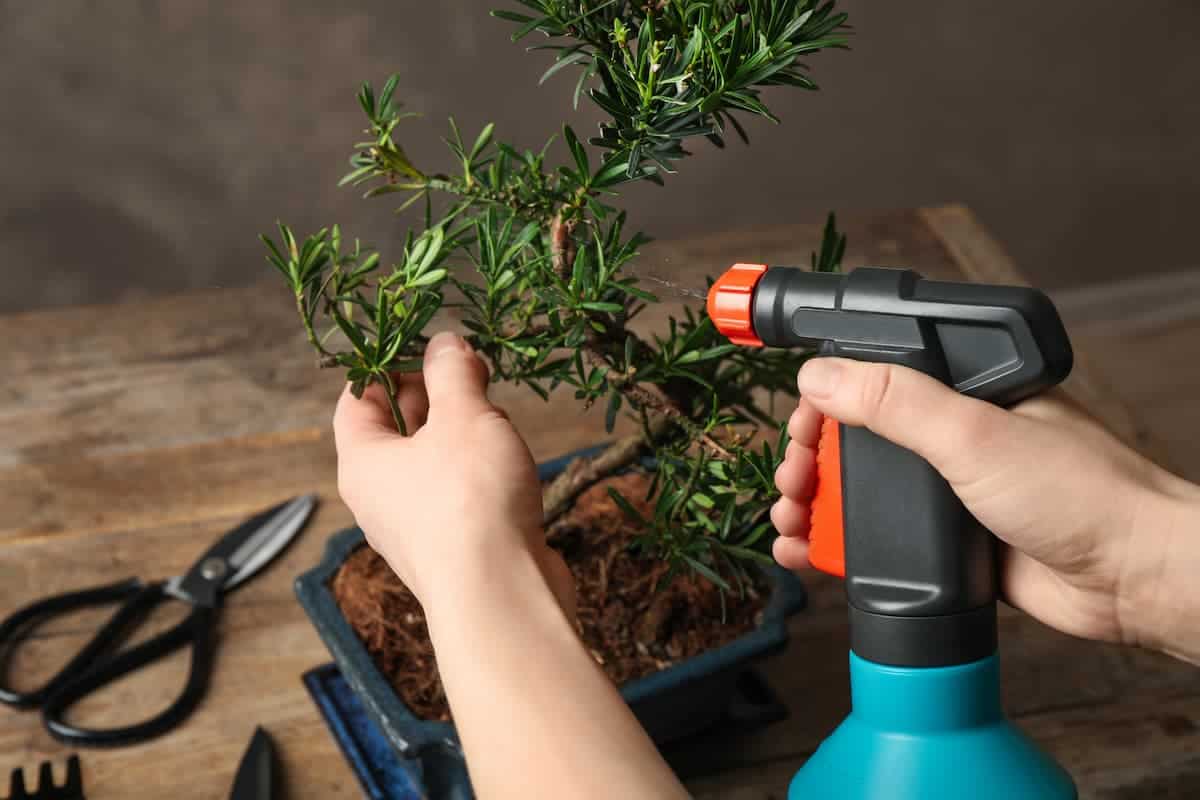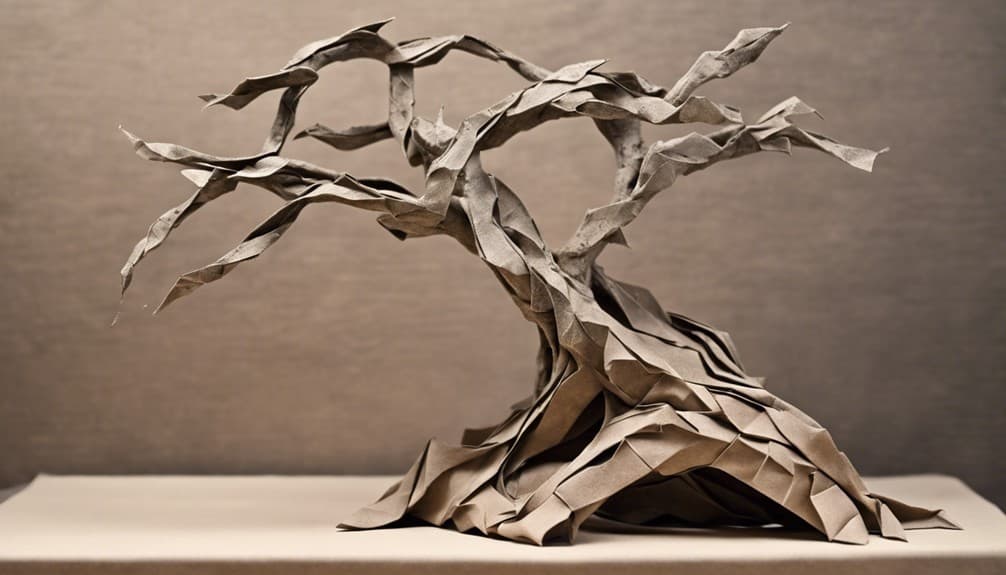Do you wish you could grow your favorite tree in your house or your backyard but don’t have the room? Consider a bonsai tree to solve your dilemma.
But can you bonsai any tree, or just certain ones? You can bonsai just about anything from herbs to bushes to fruit trees. Generally speaking, you can bonsai any plant that meets the following criteria:
- Perennial shrub or tree
- Have hard or “woody” stems
- Have branches
- Can grow in a pot
- Roots and crown can be pruned
Stick around as we explore how to bonsai a plant and the different types of plants you can bonsai.
What Is A Bonsai Tree?
The art of bonsaiing allows you to take your favorite full-sized plant or tree and turn it into a smaller, artistic version that you can grow in your yard or house.
A bonsai tree is a rendering of a full-sized tree growing in nature. It is artificially prevented from reaching its mature size.
A “bonsai” is not in itself a species of tree. Many different species of trees can be made into bonsai trees. They are typically grown in aesthetically pleasing, small pots. Some stores have been selling them for decades with trees over a hundred or more years old!
How Do You Bonsai A Tree?
Bonsai trees are fun to look at, aren’t they? But can anyone bonsai a tree, or do you need to be a green thumb to do it? Let’s take a look at the 3 most essential bonsai steps (beginning with plant selection), and you can decide for yourself.
Purchasing Your Bonsai Tree
The first thing you will need to do when getting ready to bonsai a tree(1) is to decide which kind of tree species will best fit your needs and climate.
Your decision to keep your tree indoors or outdoors will significantly affect your selection. If you decide to grow your tree indoors, you are limited to just subtropical trees. Outdoor choices include most non-tropical trees, and an indigenous tree for your area would be the best solution.
Next, you will need to acquire your seeds or pre-bonsai material.
Growing from seeds will take the longest amount of time. You may have to wait 3-5 years before you can style your tree. This option is best left as a side project. Ready-made bonsai trees are available for purchase, but they tend to be expensive.
A cheaper approach is to collect your tree from your surroundings. Alternatively, you can purchase pre-bonsai stock, which offers quick results. There are also bonsai starter kits available from some retailers.
Pruning And Wiring
You must prune your bonsai to shape your tree and keep its miniature size. Your goal is to make a miniature replica of your tree’s full-size version in nature. The best time to prune is typically in the spring.
Wiring is used to help direct the branches to grow in the direction you want them to grow. You will need to remove the wiring as the branches grow too thick for it so that it does not cut into them.
Care And Maintenance
How much and how often you water your bonsai depends on several factors, including:
- The type of tree it is
- The kind of potting soil you used
- How deep the pot is
- The climate you live in
Because the pots are typically small, the soil tends to dry up quickly, so you must water your bonsai regularly. However, you will want to avoid overwatering as this can lead to root rot.
You should re-pot your bonsai roughly every two years to prevent it from becoming pot-bound. Pot-bound plants cannot absorb water well. Don’t make a watering schedule. Instead, pay attention to your soil and water as needed.
You will need to ensure that you place your tree in the correct location. Indoor trees must stay indoors. Subtropical trees will not survive outdoors unless you live in that kind of climate. It’s important to note that even if you select a tree that is native to your area for outdoor growth, you may need to take extra care during the winter months to prevent frost from killing it off.
The small pots used for bonsai limit water and nutrient retention. Because of this, you will need to fertilize your bonsai to keep it healthy. Your tree’s species will determine how much/often you fertilize it.
Can I Make Any Plant A Bonsai?
Nearly any tree or shrub(2) can be transitioned into a bonsai. The key to making a successful bonsai is pruning the roots and foliage of the plant so that it remains dwarfed.
Bonsai is specifically created from perennial wood-stemmed tree and shrub species.
Why?
Because these plants produce actual branches and can be cultivated to remain small.
Can I Bonsai A Fruit Tree?
You can bonsai fruit trees. However, they will require more maintenance than regular fruit trees.
This type of bonsai tree will need to be planted in an untreated wood container with suitable drainage holes.
The container should be filled with half potting soil and half peat compost.
Before planting the tree, one-third of its root ball needs to be sliced off and any damaged branches pruned off. This will set the stage for the maintenance of the tree as a bonsai.
Can You Bonsai Herbs?
Interestingly enough, you can also bonsai herbs(3).
And the best part?
Your choices are almost limitless!
The factors depend on what is available to you and what you want. Common herbs used in herbal bonsai include
- Rosemary
- Thyme
- Lemon verbena
- Sweet bay laurel
- Oregano
Herbal bonsai is done basically the same way as traditional bonsai. You will start with the acquisition of the plant, either through seeds or a starter plant. A starter plant will get you going faster.
You need to ensure that you select an optimal plant for your environment, considering the amount of light and what temperature it requires.
You will also use wiring and pruning to shape and style your herbal bonsai. It is a delicate process and may take several years to achieve your desired look.
Typical bonsai soil is not optimal for herbs, so you will have to research which type of soil is best for the herb you are trying to grow.
Like traditional bonsai, you will need to provide consistent water and fertilizer to maintain the health of your herbal bonsai.
Can You Bonsai An Azalea?
While azaleas(4) can undergo the bonsai process, you will find you have the best results with the Kurume and Satsuki azalea hybrids. These hybrids are very trainable, and they will almost immediately start to make new growth wherever you cut.
You can create an azalea bonsai from a small azalea bush. Prune the canopy and trim back the roots before placing it into a bonsai dish. Then all that’s left to do is maintain it.
Can You Bonsai A Cactus?
You can have cactus plants in your home by maintaining a cactus combo bonsai, which is the collection of one or more small cactus plants. It’s similar to traditional bonsai in that the plants kept are tiny.
Specific varieties of cactus are selected based on their full-grown size. None of them will reach more than 10 inches in height.
The cactus combo bonsai requires minimal effort from you and is much easier to care for than traditional houseplants.
You only need to water this plant once a month. Anything more than this risks overwatering, the most considerable risk to the plant. It requires a lot of light but not direct sunlight.
Can You Bonsai A Eucalyptus?
There are several things to consider when deciding to bonsai a eucalyptus(5).
First of all, these trees all have high-speed growth rates, making them very hard to maintain in a small bonsai pot.
In plain English?
This means a lot of work for you, considering they can grow up to 200 feet tall in their natural habitat!
Secondly, the different species of eucalyptus have additional lighting requirements. Some require full sunlight, while others require partial shade. You must be able to satisfy the needs of the species you select.
Start with a small eucalyptus plant no more than 5 to 7 inches tall. Use a cone-shaped pot to accommodate the fast root growth.
Using the traditional round bonsai pots will make it so you cannot re-pot your plant. Ensure that it has a sound drainage system.
When selecting the soil, make sure it has a low nitrogen content and is well-draining. Eucalyptus plants do not do well with high levels of moisture and humidity.
Can You Bonsai An Avocado Bush?
While avocado plants are fast-growing in the wild, they can also be grown as bonsai.
Beginning with a starter plant is the easiest way to start the bonsai process. You will need to trim back the roots and the branches before placing the plant in a bonsai pot.
To prepare the soil, use coarse-grain soil at the bottom of the pot. Coarse-grain is a well-draining type of soil that will keep the water from building up around the roots.
You will need to use high-quality, well-draining soil for the top layer. For best results, mix it with compost to provide nutrients to the plant.
Can You Bonsai A Rose Bush?
While roses(6) usually are small shrubs, you can turn them into bonsai trees with old trunks and rough bark. Flowers begin appearing in the spring, with some species flowering until autumn’s freezing temperatures make them dormant.
Roses need a lot of water during their growing season, especially when placed in full sun. They prefer water with a pH of 6.5 to 7, and they require full sun for flower production.
You will need to fertilize the tree once a month using a solid fertilizer. If using a liquid fertilizer, then you will need to fertilize weekly.
You should only prune the rose bonsai when it is dormant. The younger branches will be easy to wire, but you will need to watch out for their sharp spines. The older branches tend to be stiff and brittle, and you will need to take care when handling them.
Rose bonsais will need to be repotted every 2 to 3 years when they are young. Older plants will need to be repotted less often. You should use soil with a pH between 6.5 and 7 that is also well-draining.
Can You Bonsai A Cherry Tree?
Cherry tree bonsais are a favorite among enthusiasts and amateurs alike because of their beautiful blossoms. They adapt very well to pruning and are relatively low maintenance.
Cherry trees can be wired throughout the year, but it is best to do it during the dormant months in the winter and fall so that you do not damage the blossoms. Additionally, do not leave the wires on for more than six months.
Cherry tree bonsais require partial sun because full sun conditions will burn their blossoms and foliage. A location that receives morning and evening light but is protected from direct afternoon light is best.
The soil for these trees has to drain well. Ground with a slightly acidic pH (between 5.5 and 6.5) is best.
Cherry tree bonsais require moist, humid conditions, and you should water them with distilled water instead of tap water. Allow the top inch of soil to slightly dry out between waterings, keeping it evenly moist but not soggy.
These trees need more water during their active growing period in the spring and summer months. You should never allow your cherry tree bonsai to dry out completely.
This species is best grown outdoors throughout the year. It prefers warm spring and summer temperatures and cool winter temperatures. Despite being hardy and moderately frost tolerant, the cherry tree bonsai needs to be protected from intense frost.
You will need to fertilize your tree every two weeks during the growing season. If your tree is older, it may require less fertilization. You will only need to fertilize once per season during the fall and winter months.
Maintain your cherry tree bonsai with regular pruning and shaping.
Do not prune until it has finished blooming, usually in the summer months. You will want to pinch back fresh shoots to shape and encourage branching. Leave heavy pruning of main branches for the winter months.
Do not remove all of the new growth. Instead, leave some new shoots to ensure the tree can keep growing. Additionally, heavy pruning may negatively affect the following year’s bloom.
To maintain the health of your cherry tree bonsai, repot it every two years. Older trees can be repotted every three to five years. Mark your calendar to re-pot in the spring before blooming has started.
When choosing the new pot for your tree, you need to consider several things:
First, these pots are designed to ensure the plant has drainage, confines root growth, and includes wiring holes. To stay within the rules of bonsai, the new pot must have a height and width that is no more than ⅔ that of the tree both to restrict root growth and aesthetics.
After repotting, keep the plant in a moderately sheltered location until the tree has established itself. When they are freshly repotted, cherry tree bonsais are very susceptible to overexposure.
Recap: Can I Bonsai Any Tree?
Bonsaiing is an artistic form of plant ownership that takes time and patience to achieve your desired look. If you’re willing to put in the time and effort, you can have an exact miniature replica of your favorite 200-foot tree in your backyard without taking up all the space!
There is undoubtedly something you can find to suit your needs with all the options. From herbs to fruit trees to bushes, there is a bonsai plant for everyone!




